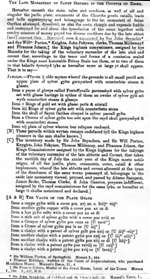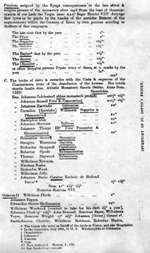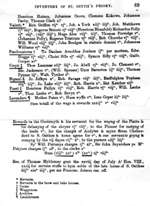
|
Dissolution of the Monasteries - Inventory of St. Osyth's Priory, c.July 153931 Monasteries were of medieval foundation. Their closure in the 1530s was a big thing. It has been calculated that one quarter of all landed wealth in England was involved, belonging to over 800 religious houses. Barking Abbey which was founded in the seventh century, had numbered royalty among its nuns, (Cuthburga daughter if Ina of Wessex was there before 750 A.D.).32 Waltham Abbey was patronised by King Harold before the Conquest, circa 1060 A.D.33 Serving God through the contemplative life was possible in such places, but over the centuries these religious centres developed as practical institutions with property to administer and bureaucracies to run them. Monasteries had a privileged position as landowners. They were exempt from tithes and feudal obligations. They held land under 'frankalmoign' or free alms. They were corporations in law. They never married and never died, so that their land did not come onto the market. It has been calculated that there were over 40 religious houses in Essex at the Dissolution owning 132 manors, (Barking Abbey had 18 manors and Waltham Abbey 14 manors). The value of all this land in 1535 was worked out at £5,660.34 By the 1530s there was doubt as to whether or not the monasteries were fulfilling their explicit responsibilities in canon law. Often the religious houses owed their allegiance to parent-houses abroad, as the monks of Prittlewell Priory did to the Abbey of Cluni near Macon in France or the 'Cistercians ' of Coggeshall did to Savigny in France. Ultimately all were obedient to the papacy. Such religious houses, their jewels and plate, their buildings and lands were jealously regarded by Henry VIII's ministers of the 1530s, who were anxious to assert the new royal authority over the church and enrichen the monarchy. It is striking how easily the dissolution of the monasteries was accomplished. Proof of this was the speed with which their properties were bought up by lay people. At first the intention seems to have been to survey the monasteries and to weed out the smaller and inefficient houses. There were precedents for such closures. Cardinal Wolsey appropriated 29 houses, six of them in Essex, (Wix, Blackmore, Thoby, Stanesgate, Horkesley and Tiptree), to create colleges at Oxford and a school at Ipswich, between 1524 and 1528. Using their new powers, the king's 'Visitors' were to ask the questions traditionally asked by bishops on their visits or inspections of monasteries, but their purpose was different. The aim of the bishops' visitations had been to uncover faults and to reform them, that of the king's visitors was to collect useful evidence on the low state of morals and spiritual life of the monks, nuns and friars, perhaps the better to justify confiscation. The visitors' report was used to get from the new Parliament of 1536 an act for the suppression of the smaller monasteries, those with revenues less than £200 a year. The revenues of the smaller religious houses were placed under a newly created 'Court of Augmentations of the Revenues of the Crown'. This was a ministry in today's parlance. Thomas Mildmay, a mercer's son of Chelmsford, became one of the ten auditors of the new court with an annual fee of £20 and 'profits'.35 These smaller houses it was alleged used their income only for the 'maintenance of sin'. In the larger houses, 'thanks be to God, religion is right well kept and observed'. Reform was the claimed aim. Henry VIII founded a completely new abbey at Bisham in 1536, although it and the larger monasteries were not safe for long. Was this great political astuteness on Henry and his ministers' part? There is virtue in gradualism. Change this-wise is supposed to be peaceful because piecemeal? Yet there came the shock of the Pilgrimage of Grace, the rebellion in the north in favour of the monasteries. This was severe. Professor Scarisbrick has spoken of this up-rising as the biggest rebellion in English history. Its support base was wide and from different social groupings. The balance of power was saved only by the ultimate 'loyalty' of the rebels. Some of the larger monasteries were declared forfeit in 1537, because their abbots were convicted of treasonable involvement in the rebellion of the Pilgrimage of Grace. A campaign of threats and blandishments then began to get the remaining monasteries to dissolve themselves and surrender their estates to the king. Waltham Abbey managed to outlast every other abbey in England, but it too formally surrendered to the king on 23 March 1540. For some religious houses and their inmates the process was a 'quiet' one of survey, valuation and inventory, followed by the granting of pensions and a withdrawal into obscurity. Others, perhaps as many as 1,800 out of an estimated total of 9,000 got no pensions and received no benefices.36 A few objected to the change. The unhappy James Mallett, rector of Great Leighs for 28 years and a former chaplain of Queen Catherine was drawn, hanged and quartered for high treason on market day Friday 1 December 1542 for openly speaking out. 'When the news was of the great Commotions in several parts of the Nation, upon and after the Dissolution of the Religious Houses,' he had said: 'Then hath the king brought his hogs to a fair market'.37 John Beche, the last Abbot of St.John's Colchester, also paid the full penalty for not surrendering or accepting the king's supremacy. 'The king shall never have my house but against my will and against my heart,' he had said. He was hanged at Colchester on 1 December 1539.38 The seizure of monastic jewels, plate, lands and buildings launched the greatest property boom since the Norman Conquest. A minimum purchase price for former monastic lands of 20 times the annual rent values was laid down in December 1539. 'Auditor' Thomas Mildmay was one of those well-placed to profit from the change and he bought the manor of Moulsham formerly belonging to Westminster Abbey on 21 January 1541 for £622 5s. 8d. He had been one of those who had signed the certificate for the pensions of the monks of Westminster Abbey. Six months after this he acquired this estate of some 1,300 acres with 200 tenancies. a watermill and valuable woodland.39 A sad postscript to the Dissolution of the Religious Houses is to be found in the deed of surrender of the Abbey of Stratford Langthorne, dated 18 March 1538, for the fifteenth signature is but the mark 'for John Wyght which can not wrytte'.40 Upsetting the balance - What did the Dissolution of the Monasteries lead to? According to James Harrington writing in Oceana in 1656 'dissolving the abbeys brought with the declining state of the nobility so vast a prey to the industry of the people that the balance of the commonwealth was too apparently in the popular party'.41 In this view, this was one of the long-term causes of the English Civil War of the seventeenth century. There were lesser results. The damage to schools and to music is difficult to calculate. Monastic libraries were dispersed, but then such texts may have enriched their new owners. Life is complicated. Chich is credited with the site of two monasteries, one of which may be legendary. St.Osyth it is said was the daughter of an English king called Frithwald and his wife Wilburga, the daughter of Penda, king of the Mercians. She was married against her will to Sighere, a king of the East Saxons, but during his absence on a huntng expedition, received the veil of a nun from two bishops. Sighere apparently consented to this and on his return granted to her Chich, where she founded a nunnery. A party of Danes invaded the country and beheaded her for refusing to abandon Christanity; but soon she rose and walked carrying her head in her hands to the church of Chich, where her remains ultimately rested, or so the account goes. Osyth was afterwards canonised, her day being 7 October. An Augustinian priory was founded in hnour of St.Osyth at Chich probably about the middle of the reign of Henry I, by Richard de Belmeis, Bishop of London (1108-1127).
|
||||||||||||
 |


